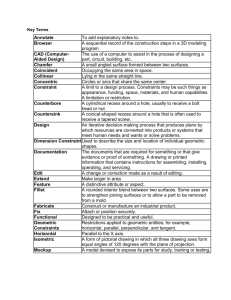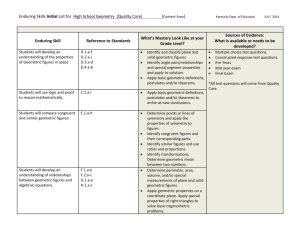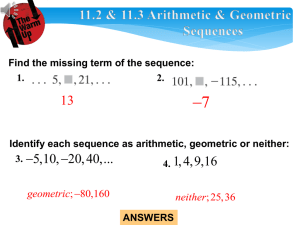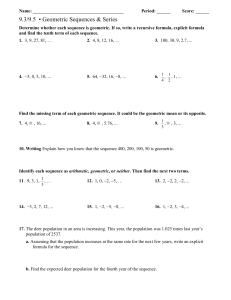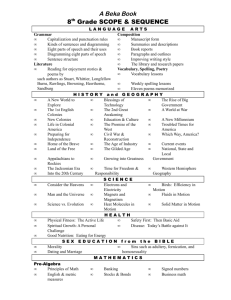8. Complex Numbers
advertisement
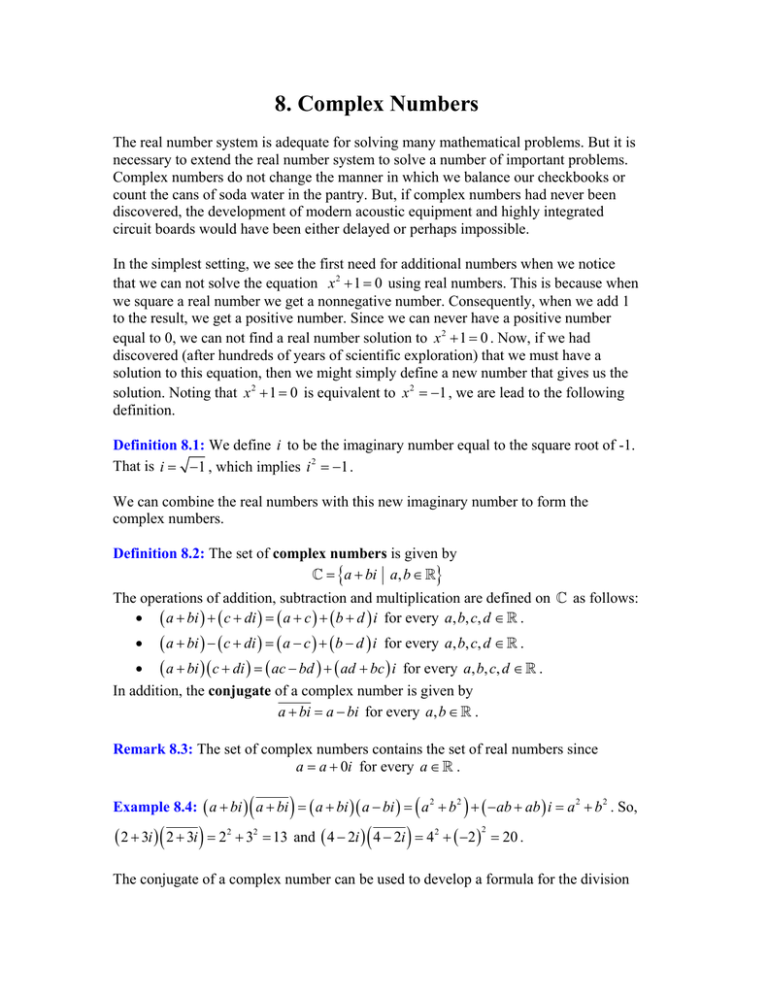
8. Complex Numbers
The real number system is adequate for solving many mathematical problems. But it is
necessary to extend the real number system to solve a number of important problems.
Complex numbers do not change the manner in which we balance our checkbooks or
count the cans of soda water in the pantry. But, if complex numbers had never been
discovered, the development of modern acoustic equipment and highly integrated
circuit boards would have been either delayed or perhaps impossible.
In the simplest setting, we see the first need for additional numbers when we notice
that we can not solve the equation x 2 + 1 = 0 using real numbers. This is because when
we square a real number we get a nonnegative number. Consequently, when we add 1
to the result, we get a positive number. Since we can never have a positive number
equal to 0, we can not find a real number solution to x 2 + 1 = 0 . Now, if we had
discovered (after hundreds of years of scientific exploration) that we must have a
solution to this equation, then we might simply define a new number that gives us the
solution. Noting that x 2 + 1 = 0 is equivalent to x 2 = −1 , we are lead to the following
definition.
Definition 8.1: We define i to be the imaginary number equal to the square root of -1.
That is i = −1 , which implies i 2 = −1 .
We can combine the real numbers with this new imaginary number to form the
complex numbers.
Definition 8.2: The set of complex numbers is given by
^ = {a + bi a, b ∈ \}
The operations of addition, subtraction and multiplication are defined on ^ as follows:
• ( a + bi ) + ( c + di ) = ( a + c ) + ( b + d ) i for every a, b, c, d ∈ \ .
•
•
( a + bi ) − ( c + di ) = ( a − c ) + ( b − d ) i for every a, b, c, d ∈ \ .
( a + bi )( c + di ) = ( ac − bd ) + ( ad + bc ) i for every a, b, c, d ∈ \ .
In addition, the conjugate of a complex number is given by
a + bi = a − bi for every a, b ∈ \ .
Remark 8.3: The set of complex numbers contains the set of real numbers since
a = a + 0i for every a ∈ \ .
(
)
Example 8.4: ( a + bi ) a + bi = ( a + bi )( a − bi ) = ( a 2 + b 2 ) + ( − ab + ab ) i = a 2 + b 2 . So,
( 2 + 3i ) ( 2 + 3i ) = 22 + 32 = 13 and ( 4 − 2i ) ( 4 − 2i ) = 42 + ( −2 )
2
= 20 .
The conjugate of a complex number can be used to develop a formula for the division
of two complex numbers. Formally, we expect
1
1
b
⎛ 1 ⎞ a − bi a − bi
=⎜
= 2
= 2
− 2
i
⎟
2
2
a + bi ⎝ a + bi ⎠ a − bi a + b
a + b a + b2
Similarly, we expect in general,
c + di ⎛ c + di ⎞ a − bi ( ca + db ) + ( da − cb ) i ca + db da − cb
=⎜
=
= 2
−
i
⎟
a + bi ⎝ a + bi ⎠ a − bi
a 2 + b2
a + b2 a 2 + b2
Definition 8.5: Division is defined on ^ via
c + di ⎛ c + di ⎞ a − bi ( ca + db ) + ( da − cb ) i ca + db da − cb
=⎜
=
= 2
−
i
⎟
a + bi ⎝ a + bi ⎠ a − bi
a 2 + b2
a + b2 a 2 + b2
for all a, b, c, d ∈ \ with a 2 + b 2 ≠ 0 .
It is possible to give a geometric interpretation of ^ . First, note that every number in
^ has the form a + bi where a, b ∈ \ . The real part of this complex number is a and
the imaginary part of this complex number is b. That is, the complex number a + bi is
completely determined by the two values a and b. As a result, it is tempting to give a
geometric interpretation of a + bi by viewing the point ( a, b ) in a coordinate system.
When this is done, the horizontal axis is referred to as the real axis and marked Re, the
vertical axis is referred to as the imaginary axis and marked Im, and the entire
coordinate system is referred to as the complex plane. We show the complex number
a + bi graphed below in the complex plane along with its conjugate a + bi = a − bi .
Im
The
Complex
Plane
a + bi
b
Re
a
a − bi
Notice that the conjugate of a complex number can be viewed geometrically as the
reflection of the complex number across the imaginary axis. We can also use the
picture above to define the notion of absolute value of a complex number. Recall that
the absolute value of a real number is its distance from 0. We can extend this to the
setting of complex numbers by noting that 0 can be written in ^ as 0 + 0i . So 0 is
corresponds with the origin in the complex plane, and we should require a + bi to be
the distance from the point a + bi in the complex plane to the origin. We can find this
value using the Pythagorean theorem as shown below.
Im
a + bi
b
a 2 + b2
a
Re
This motivates the following definition.
Definition 8.6: If a, b ∈ \ then the absolute value of a + bi is given by
a + bi = a 2 + b 2
Example 8.7: Compute 3 + i .
Solution: 3 + i = 32 + 12 = 10
Example 8.8: Give a geometric interpretation of all complex numbers a + bi satisfying
a + bi = 1 .
Solution: The complex numbers satisfying a + bi = 1 correspond to the points in the
complex plane that are 1 unit away from the origin. This is exactly the circle of radius 1
centered at the origin. Every point on the circle in the graph below satisfies a + bi = 1 .
Notice that this includes the real values -1 and 1 along the real axis, which are the real
numbers that satisfy x = 1 .
Im
a + bi
b
1
a
Re
Exercises
1. Compute (2 − 3i ) − 3 ( 4 + 2i ) − (1 − i )(1 + i ) .
2. Compute (2 − 3i ) (1 − i )(1 + i ) .
2−i
in the form a + bi for some a, b ∈ \ .
3 + 2i
4. Show that if a, b ∈ \ then a + bi = a − bi . Give a geometric interpretation of
3. Write
this result.
5. Give a geometric interpretation of complex addition. Hint: Plot arbitrary points
a + bi and c + di in the complex plane. Then draw line segments from the
origin to each of these points and complete a parallelogram as shown in the
figure.
Im
c + di
Show that the complex
number
( a + bi ) + ( c + di ) is the
a + bi
Re
additional point shown
in the figure.
6. Use the ideas from the exercise above to give a geometric interpretation of
subtraction of complex numbers.
7. Give a geometric description of the set of complex numbers a + bi that satisfy
a + bi = 2 .
8. Give a geometric description of the set of complex numbers a + bi that satisfy
( a + bi ) − (1 − 2i ) = 1 .
9. Show that the set of complex numbers is an uncountable set.
10. There is no natural way to define “<” and “>” in the complex plane so that
every pair of complex numbers a + bi and c + di can be compared. However,
it is possible to define “<” and “>” for some pairs of complex numbers. To this
end, we say that a + bi < c + di if and only if a < c and b < d for a, b, c, d ∈ \ .
Draw a picture in the complex plane of the set of complex numbers a + bi
satisfying a + bi < 2 − i .
11. Use the exercise above to give a definition of a + bi ≤ c + di for a, b, c, d ∈ \ .
Then sketch the set of complex numbers a + bi satisfying −2 + 3i ≤ a + bi .
12. Give a geometric interpretation of the set of complex numbers satisfying
a + bi ≤ 1 .
13. Give a geometric interpretation of the set of complex numbers a + bi satisfying
a + bi ≤ 1 and 0 < a + bi .
14. Give a geometric interpretation of the set of complex numbers a + bi satisfying
1
> 1 and a + bi ≤ 0 .
a + bi
15. Show that the operations addition and multiplication satisfy the field axioms on
^ . That is, for every a, b, c ∈ ^ .
Name
Addition
Multiplication
a+b =b+a
a×b = b×a
Commutative
Property
Associative
( a + b) + c = a + (b + c )
( ab ) c = a ( bc )
Property
Distributive
a ( b + c ) = ab + ac
Property
a+0 = 0+a = a
Identity
a (1) = 1( a ) = a
Inverse
There exists − a ∈ ^ so that
a + ( −a ) = ( −a ) + a = 0
if a ≠ 0 there exists a −1 ∈ ^
so that a a −1 = a −1 a = 1
